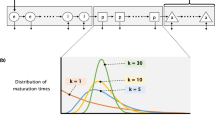Abstract
Recent studies have shown that simplistic measures of toxicity such as the LC50 do not provide enough information about the actual effects that may occur in pesticide-exposed populations over longer time periods than a few days. In this paper we discuss the use of demography and population modeling for estimation of pesticide effects on pest and beneficial species and argue that these new approaches are essential to further our understanding of the potential impacts that pesticides might have on both pest and beneficial species such as biological control agents.
Similar content being viewed by others
References
Banks, H.T., J.E. Banks, L.K. Dick and J.D. Stark Estimation of dynamic rate parameters in insect populations undergoing sublethal exposure to pesticides. Bull. Math. Bio. (in press)
Biddinger D.J., Hull L.A. (1999). Sublethal effects of selected insecticides on growth and reproduction of a laboratory susceptible strain of tufted apple bud moth (Lepidoptera: Tortricidae). J. Econ. Entomol. 92:314–324
Blumel S., Gross M. (2001). Effect of pesticide mixtures on the predatory mite Phytoseiulus persimilis AH (Acarina, Phytoseiidae) in the laboratory. J. Appl. Entomol. 125: 201–205
Butter N.S., Singh G., Dhawan A.K. (2003) Laboratory evaluation of the insect growth regulator lufenuron against Helicoverpa armigera in cotton. Phytoparasitica 31:200–203
Carey J.R. (1993). Applied demography for biologists with special emphasis on insects. Oxford University Press, New York
Castagnoli M., Angeli G., Liguori M., Forti D., Simoni S. (2002). Side effects of botanical insecticides on predatory mite Amblyseius andersoni (Chant). Anzeiger fur Schadlingskunde 75: 122–127
Caswell H. (2000). Matrix Population models: Construction, Analysis and Interpretation 2nd ed. Sinauer Associates Inc., Sunderland, Massachusetts
Forbes V.E., Calow P. (1999). Is the per capita rate of increase a good measure of population-level effects in ecotoxicology? Environ. Toxicol. Chem. 18:1544–1556
Holscher J.A., Barrett B.A. (2003). Effects of methoxyfenozide-treated surfaces on the attractiveness and responsiveness of adult codling moth (Lepidoptera: Tortricidae). J. Econ. Entomol. 96:623–628
Josan A., Singh G. (2000). Sublethal effects of lufenuron on the diamondback moth, Plutella xylostella (Linnaeus). Ins. Sci. Applic. 20:303–308
Kavousi A., Talebi K. (2003). Side-effects of three pesticides on the predatory mite, Phytoseiulus persimilis (Acari : Phytoseiidae). Exp. App. Acarol. 31: 51–58
Kim M., Shin D., Suh E., Cho K. (2004). An assessment of the chronic toxicity of fenpyroximate and pyridaben to Tetranychus urticae using a demographic bioassay Appl. Entomol. Zool. 39: 401–409
Myers G.A., Hull L.A. (2003). Insect growth regulator impact on fecundity and fertility of adult tufted apple bud moth, Platynota idaeusalis Walker. J. Entomol. Sci. 38:420–430
Overmeer W.P.J., van Zon A.Q. (1982). A standardized method for testing the side-effects of pesticides on the predacious mite Amblyseius andersoni (Acarina: Phytoseiidae). Entomophaga 27:357–364
Rezaei M., K. Talebi, N. Hosseini and A. Kavousi. Impacts of the pesticides imidacloprid, propargite and pymetrozine on Chrysoperla carnea (Stephans) (Neuroptera: Chrysopida): using IOBC and lifae table assays. BioControl. (in press)
Stark J. D., Vargas R.I., Thalman R.K. (1990). Azadirachtin: Effects on metamorphosis, longevity, and production of three Tephritid fruit fly species (Diptera: Tephritidae). J. Econ. Entomol. 83:2168–2174
Stark J.D., Wennergren U. (1995). Can population effects of pesticides be predicted from demographic toxicological studies?. J. Econ. Entomol. 88:1089–1096
Stark J.D., Banks J.E. (2003). Population-level effects of pesticides and other toxicants on arthropods. Annu. Rev. Entomol. 48: 505–519
Stark J.D., Banks J.E, Acheampong S. (2004a). Estimating susceptibility of biological control agents to pesticides: influence of life history strategies and population structure. Biol. Control 29: 392–398
Stark J.D., Banks J.E., Vargas R.I. (2004b). How risky is risk assessment? The Role that Life History Strategies Play in Susceptibility of Species to Stress 2004. Proc. Nat. Acad. Sci. 101:732–736
Stark J.D. (2005). How closely do acute lethal concentration estimates predict effects of toxicants on populations?. Integrated Environ. Assess. Manage. 1: 109–113
Sugayama, R., A. Kovaleski and J.D. Stark. A demographic modeling approach for the evaluation of the effects of eight insect growth regulators on Bonagota cranaodes (Meyrick) (Lepidoptera: Tortricidae), a key pest of apples in Brazil. Neotropical Entomol. (in press)
Wennergren U., Stark J.D. (2000). Modeling long-term effects of pesticides on populations: beyond just counting dead animals. Ecol. Appl. 10: 295–302
Author information
Authors and Affiliations
Corresponding author
Rights and permissions
About this article
Cite this article
Stark, J.D., Sugayama, R.L. & Kovaleski, A. Why demographic and modeling approaches should be adopted for estimating the effects of pesticides on biocontrol agents. BioControl 52, 365–374 (2007). https://doi.org/10.1007/s10526-006-9040-6
Received:
Accepted:
Published:
Issue Date:
DOI: https://doi.org/10.1007/s10526-006-9040-6




